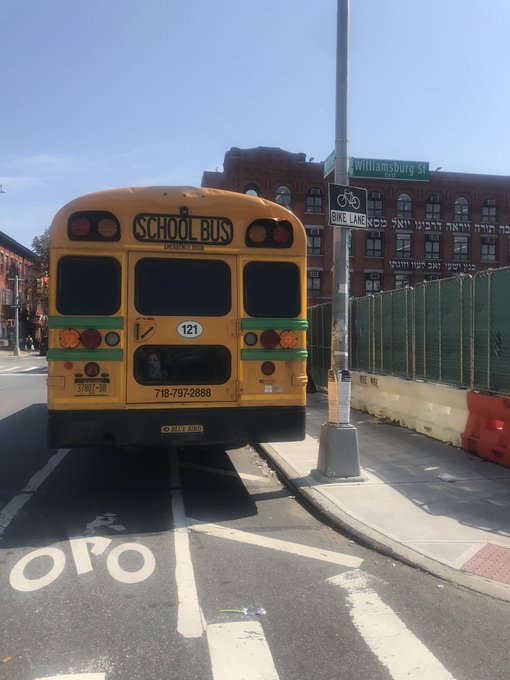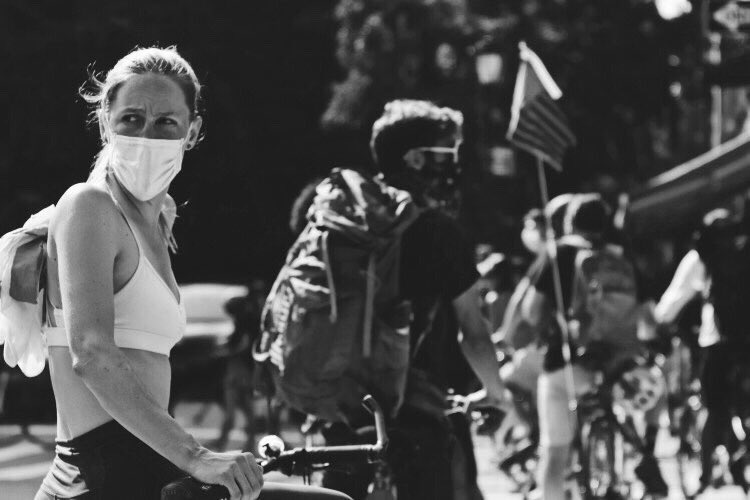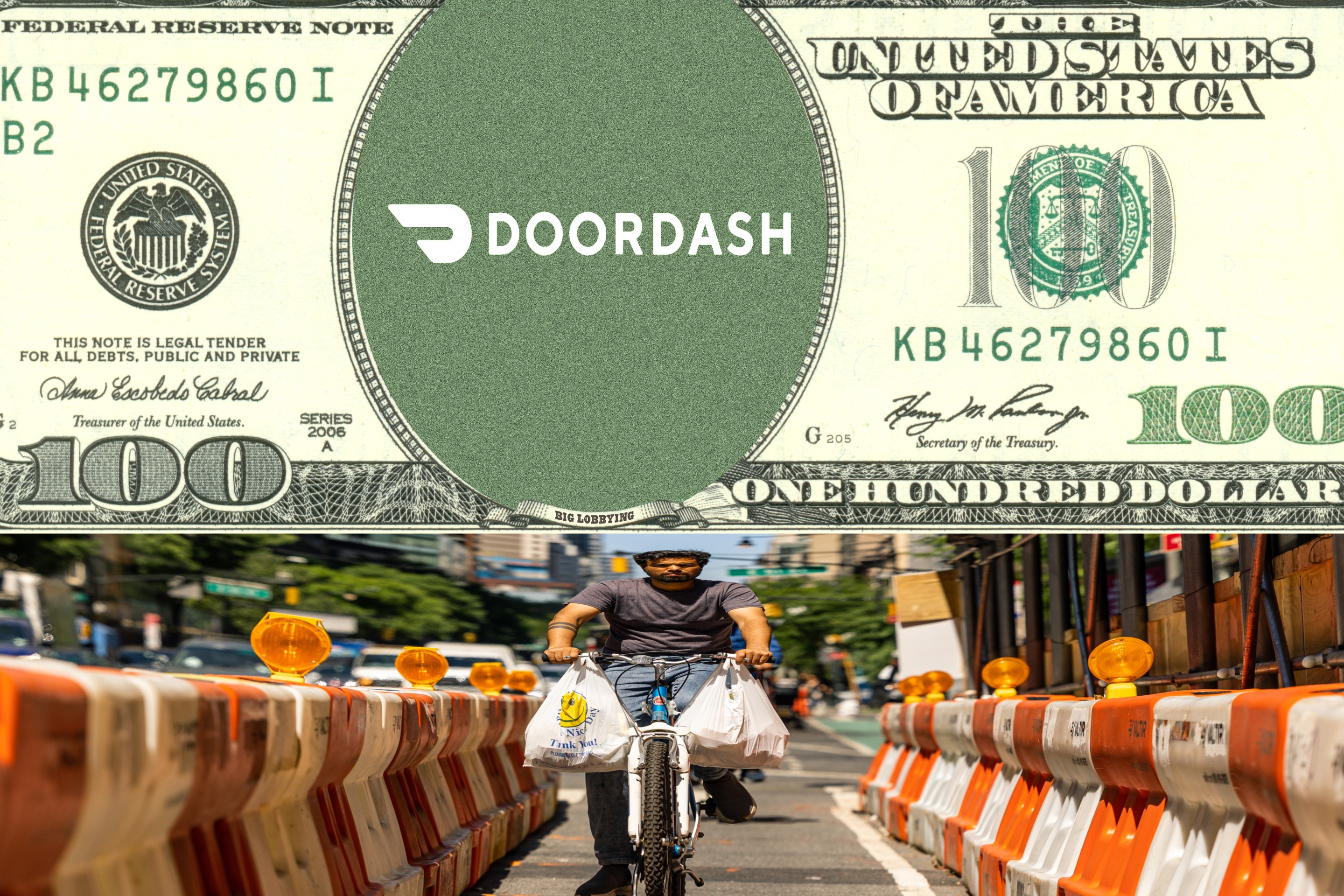The city is failing New Yorkers who are biking during a pandemic that has made people fearful of enclosed spaces like subways, says the brother of 35-year-old Sarah Pitts, who was killed while biking past a notoriously dangerous Brooklyn intersection last week.
Pitts only decided to start commuting by bike as the coronavirus gripped the city — and as Mayor de Blasio urged New Yorkers to walk or bike to work. Pitts listened to that advice, and it cost her her life, her brother told Streetsblog this week.
“[It's] so frustrating that with everything that is being done around COVID, and telling people to find other ways to get around, thousands of New Yorkers are putting themselves at risk on the streets on New York,” John Pitts said. “It’s a horrifying concept that we shouldn't accept. There’s a clear mismatch between the importance cycling has taken on, and the city’s ability to make sure people protecting themselves from COVID are also protected while biking.”
On Sept. 7, Pitts — a Brooklyn prosecutor in the District Attorney's Post-Conviction Justice Bureau, who friends and colleagues say dedicated her life to seeking justice — died after she was hit by the driver of a private bus at Wythe Avenue and Williamsburg Street East in Williamsburg at about 12:30 a.m. Friends say Pitts was heading home from a meeting with Riders For Rights, a group fighting to protect protesters’ First Amendment rights.
As a new bike commuter, Pitts was not alone. More than double the number of people have been riding on weekends compared to the same time last year, the Department of Transportation said last week. That rise was predictable, but so was the resulting rise in injuries — which jumped 43 percent the week after the mayor advised people to bike because the city did not quickly build out a temporary network of safe infrastructure.
Like most cyclists who have passed the area where Pitts was killed — where big private buses and school buses block bike lanes with impunity — she knew it was dangerous, but it was on her way home.
“She knew good areas from bad areas, her best friend told us she had talked about that intersection and how much she didn't like going through that area,” said her brother, who lives in Washington, D.C., but was in town after his sister's death.

Despite years of complaints, the area has remained a hotbed for crashes and continues to prioritize drivers over vulnerable road users. Since August, 2018, there have been 126 crashes along Wythe Avenue between Keap and Heyward streets, causing 37 injuries, including to three cyclists and eight pedestrians, according to Crash Mapper.
“If it’s a dangerous intersection my hope is it does not require legal action by a bereaved family for the city to make a change, especially with a commitment like Vision Zero, if that’s anything other than a marketing campaign,” said Pitts. “The 'zero' in Vision Zero means zero. That’s not that hard of a concept. And every day that something gets delayed is another day when that number is not zero and another day a family like mine loses someone.”
Back in March, during the early days of the coronavirus crisis and the city’s bike boom, advocates warned that a surge of newbie cyclists on streets, coinciding with an increase in speeding, would mean an onslaught of crashes and injuries, and even deaths, if the mayor didn’t just as urgently create “a more comprehensive network of protected bike lanes.”
“Bike ridership is only going to increase as the weather gets warmer,” said Joe Cutrufo of Transportation Alternatives back in mid-March. “In order to give people an alternative that lets them practice effective social distancing, and to reduce injuries, we need to see solutions — and fast.”
The de Blasio administration announced on March 20 that it would add just two temporary protected bike lanes to two very busy bike corridors — Smith Street in Brooklyn and Second Avenue near the Queens Midtown Tunnel in Manhattan. It only followed up with an additional nine miles of protected lanes on June 24 — still not enough to address the massive bike boom that took off this summer, advocates said.
“With the dramatic uptick in cyclist deaths in recent days, it’s clear that the Mayor de Blasio must do more to bring an end to traffic violence,” Danny Harris, the executive director of Transportation Alternatives, said on Sept. 10, three days after Pitts's death. "Especially now, as more commuters start heading back to work, children start heading back to schools, and bike ridership skyrockets, the mayor must work aggressively to advance a surface transportation plan and build a connected network of protected bike lanes across the five boroughs."
Pitts is one of at least 17 cyclists killed so far this year, following 2019's exceptionally bloody year, when 29 cyclists died on the streets of New York City — the highest death toll since the start of Vision Zero.
The Brooklyn District Attorney Office’s new Street Safety Bureau, which was created two months ago in order to assist the NYPD, is supporting the police investigation into Pitts's death, according to the DA's spokesman Oren Yaniv. But in cases where a victim, defendant, or witness works for the DA’s office, like Pitts did, the District Attorney refers the case to a special prosecutor, likely a district attorney in another borough.
About a week after Pitts was killed, nearly 1,000 people came out for a vigil and protest in support of the Black Lives Matter movement in her name. Even though Pitts was relatively new to biking, she used it to continue fighting for justice by joining Riders For Rights.
She was the one on the front lines, bravely blocking cars with her own body so they didn't get too close to the group.
“Sarah was a new biker in terms of a commute biker — she was not an inexperienced biker and upon becoming a new biker the next thing she did was figure out to how to use her bike to protect other people. She immediately looked for ways to help other people," said Pitts.
At night, after a full day of advocacy within the government, she volunteered with @riders4rights, Black Lives Matter, and Occupy City Hall. If you marched in a protest for racial justice in Brooklyn this year, Sarah was on a bike ahead of you, blocking traffic to keep you safe.
— John Pitts (@PolicyPitts) September 9, 2020
The Pitts family watched via a live-stream the entire vigil and protest as it moved powerfully from Fort Greene to Williamsburg on Sept. 11. But Pitts said he was disappointed that police aggressively broke it up.
“It was amazing, the organizers did a live stream so the whole family watched the entire march," said Pitts. “Cops basically disrupted the vigil, which is not great from a family perspective. It’s not a great capstone to what was a beautiful evening. She would have formed a line of bikes to protect the vigil.”
There’s something profoundly prophetic about demanding justice for a woman whose whole life was dedicated to just that pic.twitter.com/LAFZeNsEry
— Julianne Cuba (@Julcuba) September 12, 2020
Pitts — who is a rider himself but says he hasn’t yet been able to get back on the bike — hopes that a future New York City mayor will do more to protect people like his sister, people just trying to get to work, get home, or people like Sarah Pitts, who put their bodies on the line to fight for justice for others.
“The most cathartic thing has been so many have had a chance to see her story and even take something good out of her death," he said. "The city can certainly do something to prioritize pedestrians and cyclists at a moment they are telling everyone it's a safe way to commute. Protected bike lanes on as many streets as possible, clear sight lines — and a real commitment to thinking about streets as something that are pedestrian first, cycling second, car third, because walking down a street in New York there are more people than there are cars. Prioritizing pedestrians and the movement of pedestrians and bikes over cars."






